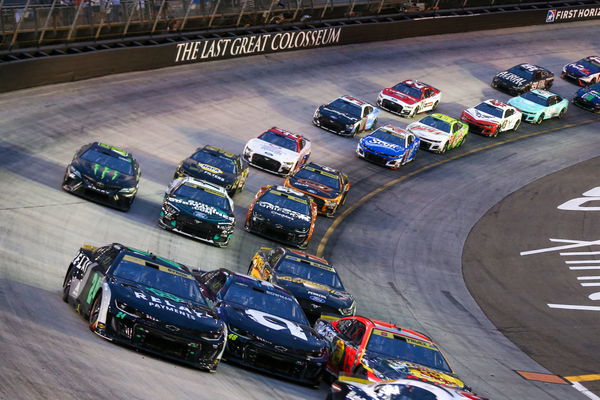
USA Today via Reuters
Sep 16, 2023; Bristol, Tennessee, USA; NASCAR Cup Series driver William Byron (24) and driver Martin Truex Jr. (19) and driver Alex Bowman (48) during the Bass Pro Shops Night Race at Bristol Motor Speedway. Mandatory Credit: Randy Sartin-USA TODAY Sports

USA Today via Reuters
Sep 16, 2023; Bristol, Tennessee, USA; NASCAR Cup Series driver William Byron (24) and driver Martin Truex Jr. (19) and driver Alex Bowman (48) during the Bass Pro Shops Night Race at Bristol Motor Speedway. Mandatory Credit: Randy Sartin-USA TODAY Sports
NASCAR and Goodyear have once again failed to deliver on their promise of improving the short-track package. The spring race at the Bristol Motor Speedway was believed to be the turning point to end the Next Gen car’s woes. However, after a full circle to the fall race in the playoffs, the ghosts of the past have come back to haunt NASCAR.
Surprisingly, NASCAR has rolled out the same tire compound that resulted in the excessive tire fall-off last time around. But looking at the drivers going green without having to worry about their tire wear is indeed surprising. This concern was highlighted by NASCAR reporter Matt Weaver, who couldn’t seem to wrap his head around how the trends of racing have changed at the World’s Fastest Half-Mile.
Taking to his X account, he wrote, “Fascinating to me that Goodyear says these are the exact same tires from March, but there is just a DRASTIC level of falloff difference between these two races. You can tell me they’re the same but these don’t even look remotely similar. Not calling them liars. It’s just WILD.” After Weaver shared the observation, fans also chimed in with their thoughts and opinions on the topic.
ADVERTISEMENT
Article continues below this ad
Fascinating to me that Goodyear says these are the exact same tires from March but there is just a DRASTIC level of falloff difference between these two races
You can tell me they’re the same but these don’t even look remotely similar
Not calling them liars. It’s just WILD.
— Matt Weaver (@MattWeaverRA) September 22, 2024
Fans react to Goodyear’s failed intervention for the Bristol race
The spring race did catch multiple teams and drivers off-guard. And in the era of the Next-Gen cars, they could have made the right adjustment to overcome the blistering of the rubber on the tires this time around. This is the theory of a race fan who believed that the teams came prepared for the challenge this time around. “Tires only matter if the teams don’t know what to expect. They knew about it and set the cars up for it.”
ADVERTISEMENT
Article continues below this ad
The Goodyear tires ran about 60 laps or so during the spring race. However, the drivers were able to put 100 or more laps on the same tire compound in the playoffs race. Although weather and team preparation can alter the tire wear, this was just unprecedented. This leads to questions regarding the quality control on Goodyear’s end, “If they are the same, it has to make you wary of their manufacturing standards.”
NASCAR and Goodyear were quick to come out and take the credit for a rather eventful race earlier this year. They even assured that a similar tire compound would improve racing at other short- tracks, which hasn’t proved to be true. In fact, their soft tire experiment at the All-Star race was a no-show. So seeing NASCAR reach the same problems they had at the start of the year was indeed frustrating for the fans. And they didn’t hesitate to call them out as liars, “Go ahead, call them what they are. Bunch of liars.”
What’s your perspective on:
Are Goodyear's excuses for Bristol just smoke and mirrors? What do you think?
Have an interesting take?
Larson led over 400 laps during this race and was practically untouchable by the rest of the competition. While it may add more records and trophies to the Hendrick Motorsports team, it wasn’t an entertaining watch for the fans. Track position was indeed the king today, and therefore, there was no real action or drama. This was the final race of the first round, but it felt like a normal race event. Disappointed with the racing on display, a user on X replied, “And extremely boring as well.”
ADVERTISEMENT
Article continues below this ad
Some even questioned Goodyear’s capabilities to design a tire that falls off. They could’ve gone lucky with the spring race and how the resins reacted with the racetrack. Mind you, the spring race was the first event back on a concrete surface after it ran on a dirt track. So there could be a possibility; just the shift in racing surface allowed for a drastic reaction onto the tires, and Goodyear practically had nothing to do with it. “I genuinely think that Goodyear is incapable of making a tire with fall off.”
Time and again, teams and drivers have demanded more horsepower. A demand that is often neglected by NASCAR. Perhaps it is time NASCAR looks in the other direction and give the drivers what they want.
ADVERTISEMENT
ADVERTISEMENT
ADVERTISEMENT
ADVERTISEMENT


Are Goodyear's excuses for Bristol just smoke and mirrors? What do you think?